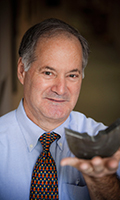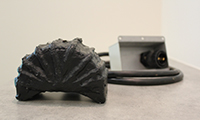Charles M. Epstein, MD, or “Chip” as he’s been known since childhood, is a professor of neurology specializing in epilepsy and the founder of the Laboratory for Transcranial Magnetic Stimulation (TMS). He is also a co-inventor for the technology that is utilized by Emory partner Neuronetics, Inc in their NeuroStar TMS Therapy® for treating depression. Neuronetics has safely administered more than 10,000 NeuroStar TMS Therapy® treatments with clinically significant results: among patients studied, 54 percent responded to the therapy and 33 percent found their depression in remission.
Neurostar wasn’t the first technology you were involved with. Could you tell us about some of your previous technologies?

Charles Epstein, MD
NeoControl was actually the first magnetic technology that went on the market thanks to Neotonus. This company was the first to develop TMS to treat urinary incontinence in women.
World wide, women have been more prone to urinary incontinence than men. This was especially true after childbirth and before modern obstetrics. Using electromagnetics, treatment is much more comfortable than prior methods. The magnets work right through clothing and are essentially painless. This was the foundation of Neotonus’ technology, NeoControl. Unlike brain stimulation, TMS in the pelvic area takes even more power and without our technology, would have been impractical. The company was moderately successful with sales primarily in Asia, but ultimately went out of business during the recent recession.
Does TMS have a role in your current research?
I continue to use TMS in several kinds of brain research, and am beginning a preliminary collaboration to explore its potential for experimental stroke treatment. My “day job” is epilepsy. TMS hasn’t been used as much in the epilepsy field, though, and the reason for this is a bit complicated.
In simple terms, we don’t use TMS for epilepsy as much because epileptic seizures often come from too deep in the brain and are difficult for us to reach. Often times we don’t even know precisely where the seizures are coming from, so we wouldn’t know where to aim with the stimulator—or be able to guarantee that we could cover a big area.
Do you think TMS could be used to treat other medical conditions?
With other conditions, the data is promising but too limited to know exactly how effective it is. Far more conditions have been reported to respond to TMS than I think are likely to hold up, but there’ll need to be more studies to determine that.
How did your work with magnets come about and progress?
The funny thing is, the basis of this technology is something I put together in my basement. The coil is the key; it’s what makes NeuroStar so much more reliable and cheaper to build.
To give you a sense of the power requirement for TMS, think about this: A standard light bulb uses 100 watts of electrical power. 100 watts gives you a fair amount of light. TMS comes in pulses, usually 10 pulses over and over. For other systems, a single pulse requires up to 5 million watts. That’s 50,000 standard light bulbs going off all at once for a tiny fraction of a second, a ten-thousandth of a second, to be exact. Now, to do that takes a lot of power and generates a lot of heat. What we’ve invented takes a quarter of the power, and produces eight times less heat on a person’s head. We no longer need to keep air and water running around the coil to cool it.
What is it like to work on a project and meet a patient whose life has been changed by your technology?

First Magnet Prototype for TMS
What’s it like to work on a project and meet a patient? It’s fantastic! To have built something in the basement that is out there treating thousands of people and making them better and changing their lives is amazing. And, even by extension, making it possible for other magnetic stimulators to make lives better – because likely none of them would have been cleared for sale if it weren’t for NeuroStar – is positive.
In general what was the process of creating NeuroStar like?
Well, science and medicine are a lot more chaotic and random than they appear from outside. And what you see in pictures is older scientists frowning in white coats. What people don’t see often enough is that science is actually fun, along with hard work. That fun and playfulness are fundamental to a lot of new things, and were fundamental to NeuroStar. I was essentially playing in a lab and in my basement with a different goal, and with no idea what this coil would lead to. Alexander Fleming is famous for the fact that he was playing with bacteria when he created penicillin. A big part of discovery is play. This has been fun from beginning to end, and hopefully we’re not at the end.
What has been the most satisfying part of seeing NeuroStar hit the market?
My job is to make people better and it’s very gratifying that NeuroStar has multiplied the number of people I can make better by hundreds and thousands. That’s a great feeling that I don’t think I would have experienced otherwise.
There are six videos on the Emory’s TMS technology listed below:
-
Video Playlist:http://bit.ly/1mGx3IV
-
Depression, TMS & Emory:http://bit.ly/1kMsKui
-
Depression and its Stigma: http://bit.ly/1JuvKah
-
How does TMS Work and Feel:http://bit.ly/1O5qUPK
-
The Difference Between ETC and TMS:http://bit.ly/1UwKUMP
-
Martha Rhodes, Interview by Todd Sherer:http://bit.ly/1Z5ZvQE
-
Martha Rhodes Presentation, Sharing her Story of Depression and TMS:http://bit.ly/1mCxbcM
This piece is one in a series of four blogs related to Emory’s TMS technology. They look at the development and management of the technology, its impact, and this project from several points of view.
-
The Magic of Science and How TMS Saved Me, by Martha Rhodes: http://bit.ly/1JXRqGR
-
Case Managers’ Reflect on Their Time with TMS (an interview): http://bit.ly/1OOBN5B